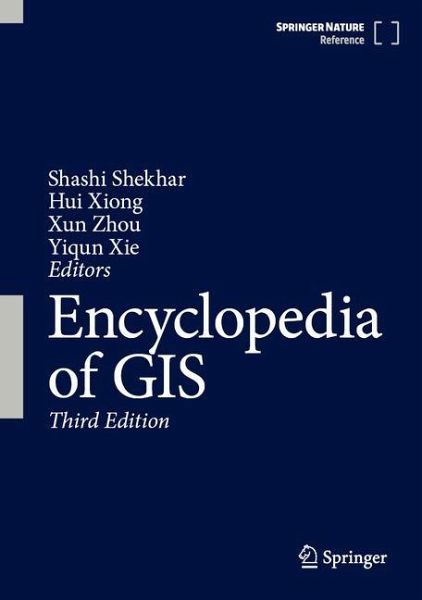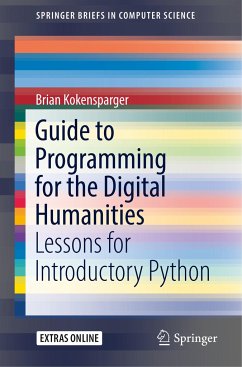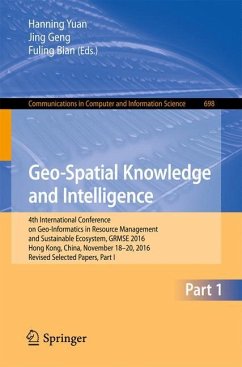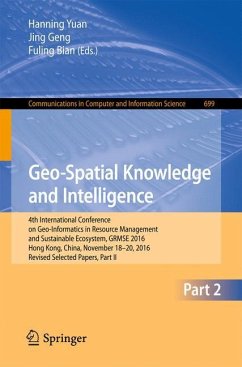
Encyclopedia of GIS
Versandkostenfrei!
Versandfertig in 6-10 Tagen
264,99 €
inkl. MwSt.

PAYBACK Punkte
132 °P sammeln!
The first two editions of the encyclopedia are comprehensive in the coverage of established GIS concepts, applications, and platforms. However, the field is growing quickly and there is a need to cover recent trends and developments. The goal of the third edition is to cover the recent trends since the second edition(2017). It will divide the trends into three areas namely GIS concepts, methods and theories (e.g., Geographic Knowledge graphs, convolutional and spatial variability aware neural networks), GIS use-cases and applications (e.g., Geo-AI, Contact Tracing, spatial pathology), and GIS ...
The first two editions of the encyclopedia are comprehensive in the coverage of established GIS concepts, applications, and platforms. However, the field is growing quickly and there is a need to cover recent trends and developments. The goal of the third edition is to cover the recent trends since the second edition
(2017). It will divide the trends into three areas namely GIS concepts, methods and theories (e.g., Geographic Knowledge graphs, convolutional and spatial variability aware neural networks), GIS use-cases and applications (e.g., Geo-AI, Contact Tracing, spatial pathology), and GIS platforms (e.g., nano-satellites, UAVs, microscopes) and datasets (e.g., Multiplexed immunofluorescence imagery and cell level maps).
The new edition will cover novel and interesting GIS use-cases and applications which are being developed in the area of pandemic management, smart cities, electric vehicles, and so on to address emerging societal needs. For example, there has been a rapid development of contact-tracing apps to assess COVID-19 spread across geographic regions. Similarly, the development of digital twins allows a virtual look ahead into future city infrastructure, operational management,
etc. Further, GIS support is critical for optimal placement of charging stations and real-time determination of optimal routing operations amongst others. Beyond these there are other relevant applications being developed in the field of autonomous vehicles, spatial pathology, etc.
The new edition also covers novel emerging applications which support infrastructure such as IoT and embedded spatial computing platforms, unmanned aerial vehicles (UAVs), nano-satellite constellations, edge computing, and so on. For example, devices like OAK-D can perform real-time collision detection of bicycle riders. Similarly, rapid development of software libraries helps UAV devices in real-time imagery collection, etc and perform other operations such as geo-fencing, etc. Further, with a significant increase in the number of space-borne nano-satellites, commercial access to large-scale geospatial imagery is increasing rapidly. This has led to the emergence of multiple commercial geospatial cloud computing platforms (e.g., AWS Earth, Google Earth Engines, NEX). Besides these, trends such as location-aware edge computing, geo-collaboration via volunteered geographic information systems are also emerging.
Finally, this edition will cover novel GIS and spatial computing trends which advance fundamental GIS. For example, with an increased reach of spatial technology and computational tools across society there are calls for responsible spatial data science to develop methods, processes, and algorithms which do no harm to
society. Further, deep-spatial aims at developing spatially-explicit deep learning based models. To enable efficient and accurate spatial data search and management the semantic relationship between different spatial entities (e.g., point of interests) are being modeled as spatial knowledge graphs. Besides these, fundamental GIS developments are taking place in 3D positioning and orientation (for VR, UAV/aircraft navigation, brain surgery), differential privacy and quantum spatial computing.
Scope: The new edition will not cover topics where we may not find field editors. Moreover, we will not cover GNSS and satellite systems from countries other than the US. Finally, we will not cover controversial geo-political topics (e.g., gerrymandering, role of maps in warfare).
(2017). It will divide the trends into three areas namely GIS concepts, methods and theories (e.g., Geographic Knowledge graphs, convolutional and spatial variability aware neural networks), GIS use-cases and applications (e.g., Geo-AI, Contact Tracing, spatial pathology), and GIS platforms (e.g., nano-satellites, UAVs, microscopes) and datasets (e.g., Multiplexed immunofluorescence imagery and cell level maps).
The new edition will cover novel and interesting GIS use-cases and applications which are being developed in the area of pandemic management, smart cities, electric vehicles, and so on to address emerging societal needs. For example, there has been a rapid development of contact-tracing apps to assess COVID-19 spread across geographic regions. Similarly, the development of digital twins allows a virtual look ahead into future city infrastructure, operational management,
etc. Further, GIS support is critical for optimal placement of charging stations and real-time determination of optimal routing operations amongst others. Beyond these there are other relevant applications being developed in the field of autonomous vehicles, spatial pathology, etc.
The new edition also covers novel emerging applications which support infrastructure such as IoT and embedded spatial computing platforms, unmanned aerial vehicles (UAVs), nano-satellite constellations, edge computing, and so on. For example, devices like OAK-D can perform real-time collision detection of bicycle riders. Similarly, rapid development of software libraries helps UAV devices in real-time imagery collection, etc and perform other operations such as geo-fencing, etc. Further, with a significant increase in the number of space-borne nano-satellites, commercial access to large-scale geospatial imagery is increasing rapidly. This has led to the emergence of multiple commercial geospatial cloud computing platforms (e.g., AWS Earth, Google Earth Engines, NEX). Besides these, trends such as location-aware edge computing, geo-collaboration via volunteered geographic information systems are also emerging.
Finally, this edition will cover novel GIS and spatial computing trends which advance fundamental GIS. For example, with an increased reach of spatial technology and computational tools across society there are calls for responsible spatial data science to develop methods, processes, and algorithms which do no harm to
society. Further, deep-spatial aims at developing spatially-explicit deep learning based models. To enable efficient and accurate spatial data search and management the semantic relationship between different spatial entities (e.g., point of interests) are being modeled as spatial knowledge graphs. Besides these, fundamental GIS developments are taking place in 3D positioning and orientation (for VR, UAV/aircraft navigation, brain surgery), differential privacy and quantum spatial computing.
Scope: The new edition will not cover topics where we may not find field editors. Moreover, we will not cover GNSS and satellite systems from countries other than the US. Finally, we will not cover controversial geo-political topics (e.g., gerrymandering, role of maps in warfare).












